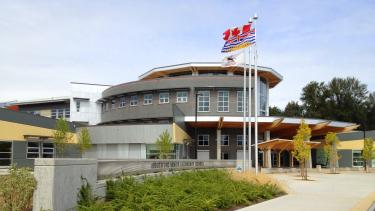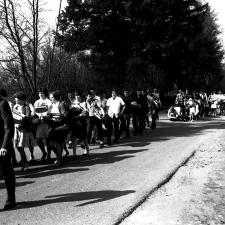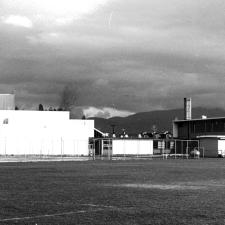
School Name History
Location
33355 Bevan Avenue, Abbotsford, BC
Opened
1955; 1966 moved to the Abbotsford Junior High School building; 2006 renamed Abbotsford Collegiate after merging with the Career Technical Centre: 2012 renamed Abbotsford Senior Secondary after major renovations
The School
Abbotsford Senior Secondary opened on Bevan Avenue in October of 1955. It had sixteen classrooms, three industrial arts shops, a combination gymnasium and auditorium, a lunchroom, and administration offices. The new school also received the furnishings of the former home economics room from Phillip Sheffield High, which had to be divided into three sections then individually transported.
In April of 1966, Abbotsford Senior switched buildings with Abbotsford Junior High School, which had opened in 1952. The school board felt the Senior High building offered more opportunity for enlargement to accommodate the Junior High population. Abbotsford Senior Secondary was now at 2329 Crescent Way and the Abbotsford Junior High School students moved to its old building on Bevan Avenue.
In 1993, Clearbrook Junior High School closed and in 1994 the Career Technical Centre moved into the building. The CTC was a new program developed jointly with the University of the Fraser Valley. It offered a mixture of high school and first year university courses in various technological, trade, and other career areas.
In the fall of 2006, CTC merged with Abbotsford Senior Secondary. The CTC moved from its Clearbrook site to the Abbotsford Senior Secondary building. Now students from Grades 9 and 10 studied the usual subjects but, in Grades 11 and 12, they could choose from courses in trade, technology, and university preparation academics. They could graduate with a high school degree and one year of post-secondary credit. The school was renamed Abbotsford Collegiate, a name that reflected its new function and its association with the university.
In 2010, the ground-breaking for a renovation of the senior high school building began. It involved replacement of some classrooms and shops, and a new administration area. The renovation included new playing fields and a Neighbourhood Learning Centre. The school now shared common space with community agencies such as daycare, counselling and seniors’ services. The common space included a computer lab, kitchen, and other offices. A three-storey rotunda connected the old and new sections. In 2012, the school opened with a capacity of nine hundred fifty students. Its name was changed back to Abbotsford Senior Secondary School.
Origin of the Name
The school was named after the community. Abbotsford was named by an early settler, John Charles Maclure. In 1888, Maclure and his business partners sold the right of way through his land to the Canadian Pacific Railway. He sold the right of way on the condition that they build a train station there. He named this place Abbottsford in honour of a family friend, Henry (Harry) Abbott. Abbott was the western superintendent of the Canadian Pacific Railway. Originally, on maps and documents, the name was spelled with two ‘t’s. In 1922, there was a petition to change the spelling to “Abbotsford,” like the name of the home of a famous Scottish writer, Sir Walter Scott. In a letter from written in 1924, Maclure said the town was named after Harry Abbott, but still, the modern spelling with one ’t' links the town’s name to Sir Walter Scott’s home.
Scott named his home after a nearby river crossing or ford. The crossing was called Abbotsford because the monks of an abbey used the ford to cross the River Tweed. An abbey is a religious community whose leader is called an abbot
The Community
For thousands of years, the Sto:lo, the People of the River, lived here in the Fraser Valley. In the 1800s, the Sto:lo were displaced as people from Britain, Europe, and other countries arrived. The gold rush of 1858 brought the first wave of people from all over the world. By the 1860s, new settlers began establishing farms on the Sumas and Matsqui Prairies. The coming of the Canadian Pacific Railway in 1887 brought another wave of settlers. The dense forests disappeared as they were cleared for farmland and lumber mills sprang up. The village of Abbotsford was established in 1891. Abbotsford grew over the years to a town and finally to a city in 1995 when it joined with Sumas and Matsqui.


